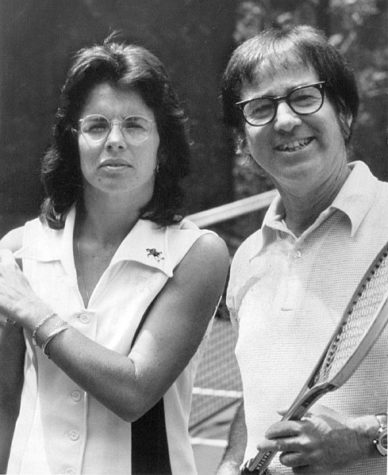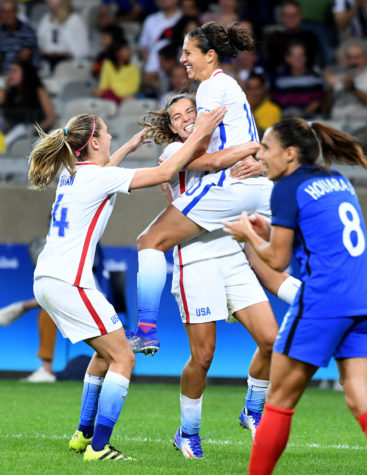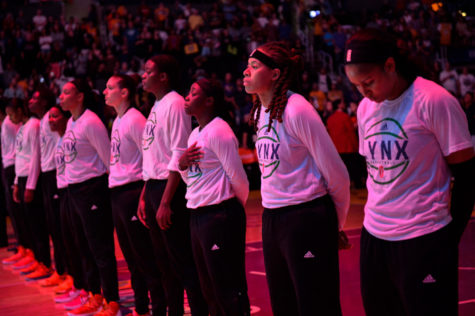Stop the Battle of the Sexes
Female athletes get the short shrift in almost every sport, but what’s new?

The 1973 tennis match between Billie Jean King and Bobby Riggs became the most watched televised sports event of all time.
For years, so-called “experts” claimed that distance running was detrimental to women’s health and femininity and for that same reason, women weren’t allowed to officially enter the Boston Marathon. In 1967 Kathrine Switzer entered the race as “K.V. Switzer” in an attempt to hide her gender. An official tried ejecting her from the course two miles in, but despite the supposed damage that was being caused by all that treacherous running, she finished, becoming the first woman to complete the race as an official entrant.
Athletes like Switzer have fought decades for a seat at the table in their sports. But, now that females have a seat, they are still waiting for the rights that the Equal Pay Act, Title VII and Title IX ensure them.
Females athletes in most cases, work harder and longer to obtain success yet, are not rewarded nearly as much as men who barely accomplish mediocrity in their sport. Males already have the physical upper hand and by giving them more superior platforms to enhance their status in the sports and economic world, we are in fact neglecting the strides women have and are still making to be rewarded for their accomplishments.
There’s no need to look further than the 28 members of the United States Women’s National Soccer Team who are suing the U.S. Soccer Federation for violations of the EPA and Title VII of the Civil Rights Act. The men’s team has historically been mediocre, never winning a Fédération Internationale de Football Association World Cup.

USA’s Carli Lloyd jumps into the arms of teammate Heath Tobin after scoring a goal against France in the second half during Summer Olympics action in Belo Horizonte, Brazil, on Saturday, Aug. 6, 2016. The U.S. won, 1-0. (Wally Skalij/Los Angeles Times/TNS)
The women’s team, on the other hand, is the most successful in international women’s soccer, with three FIFA World Cup wins, including the first ever Women’s World Cup in 1991, 61 years after the first men’s Cup.
The women’s players argue that they are required to play more games than the men’s team, win more of them, and yet still receive less pay from the federation, according to The New York Times. At the same time though, it’s hard to make direct comparisons between the compensations of the two teams. The women receive guaranteed salaries supplemented by small match bonuses while the men get higher game bonuses when they play in the U.S. but are only paid when they make the team.
Soccer isn’t the only sport paying little attention, and money, to their women’s teams. In the world of basketball, six-figure deals aren’t rare, unless you are a woman. The players of the Women’s National Basketball Association have been fighting a similar fight to the USWNT. In the National Basketball Association, players often make millions because of the multibillion-dollar industry they have been drafted into. This is partially due to the differences between the NBA and WNBA’s collective bargaining agreements. The NBA’s indicates the players must receive about 50 percent of the league’s basketball-related income. Conversely, WNBA players get less than 1/5 of league revenue according to Forbes.
The minimum starting salary in the NBA is approximately eight times the average WNBA players, according to the New York Times. Many players like Phoenix Mercury’s Brittney Griner, Seattle Storm’s Breanna Stewart and Las Vegas Aces’ A’Ja Wilson are currently playing overseas and will have no time to rest before the WNBA regular season begins May 24. Why do these players play overseas? More pay for play.

The Minnesota Lynx stand for the national anthem without their arms crossed for the first time before game four of the WNBA Finals on Sunday, Oct. 1, 2017 at Staples Center in Los Angeles, Calif. (Aaron Lavinsky/Minneapolis Star Tribune/TNS)
Men play internationally if they aren’t drafted into the NBA while 46 percent of WNBA players go overseas to get paid close to what their talent is worth. The sad reality is that both men and women basketball players grow up thinking the NBA and WNBA are their goals. But only for one association does the hard work reap the benefits. Yes, the NBA is much older, gets free daily advertising and has received billions of subsidies. But, that doesn’t discount the lengths their league goes to give back to the people who are the reason they generate that money. The WNBA needs to remember who generates their money and give their players the compensation they deserve.
From Terry Williams Munz, the first woman to be awarded an athletic scholarship until the fall of 1972 for the very first time to Billie Jean King who advocated for female tennis players to earn equal prize money in tournaments that featured players of both sexes, women have continually fought for gender equality. But, on the Forbes “The World’s Highest Paid Athletes” list, there is not a single woman. Not one.
As a society, we need to do better in supporting women’s sports and urging their employers to compensate them in a way that reflects their athletic accomplishments. We cannot allow female athletes to endure the same gender discrimination that Switzer, King and countless other female athletes have faced in the past. King said it best: “Everyone thinks women should be thrilled when we get crumbs, and I want women to have the cake, the icing and the cherry on top, too.”


